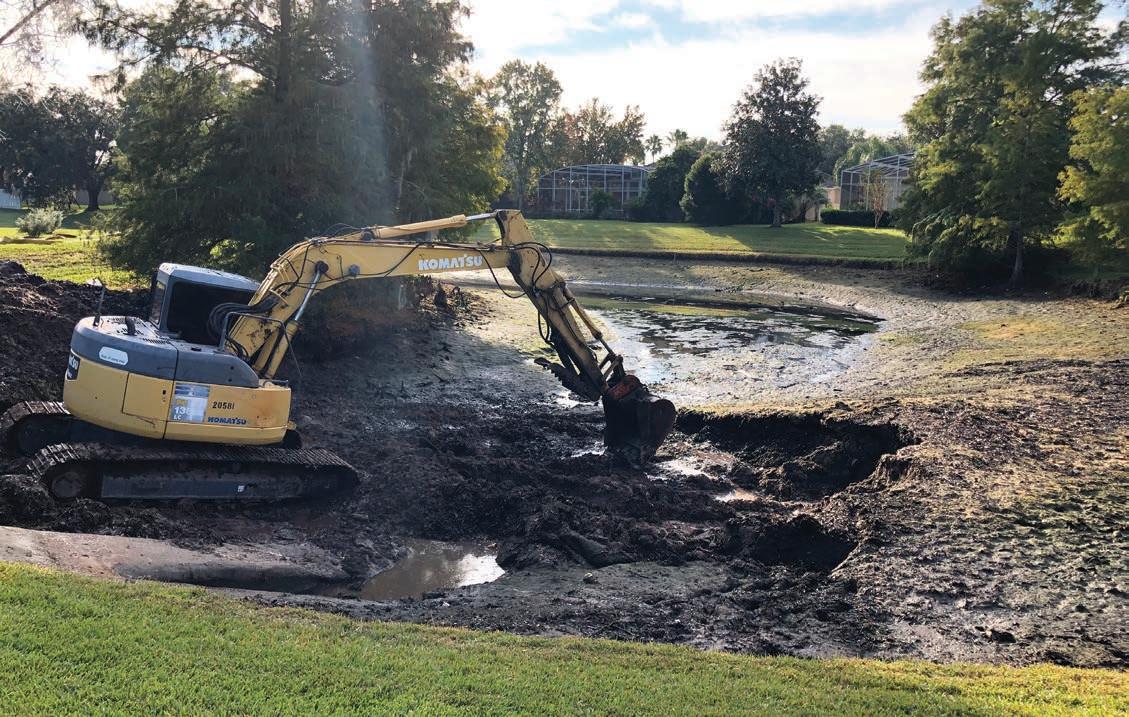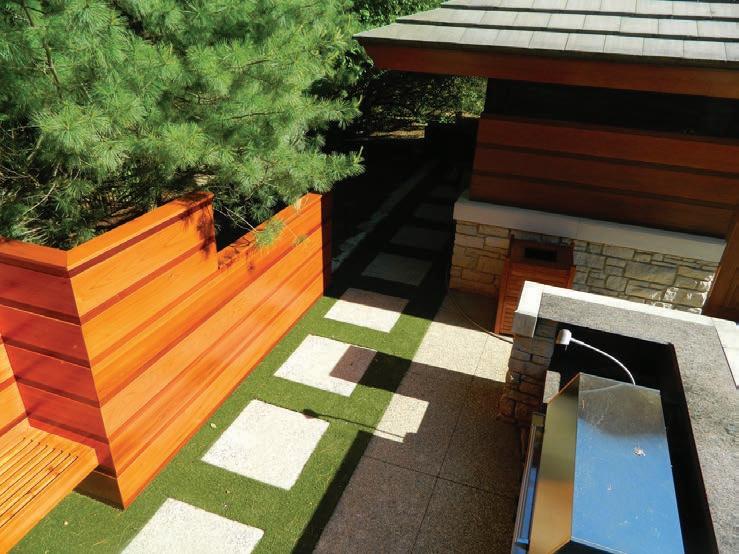
4 minute read
Lake Dredging 101: What Is Dredging?
By Trent Nelson, SOLitude Lake Management
Very much like a living organism, lakes go through many changes. Several factors affect their health and well-being, but almost nothing is as detrimental to the health of your golf course waterbodies as sediment buildup that creates an inability for it to retain water. Proactive lake management strategies, such as aeration, nutrient remediation, and buffer management, can help keep lakes healthy. However, as your waterbody naturally ages and accumulates more and more sediment, dredging may be required to return the lake to its original healthy state.
Advertisement
Lakes regularly go through the naturally occurring process of sedimentation—when sand, silt, and debris gradually accumulate on the bot-
tom of the waterbody. Over time, this sediment continues to build up and can cause serious issues, such as noxious odors, discoloration, scum, algae, and aquatic weed overgrowth. If left unmanaged, the situation often becomes increasingly dire, and your waterbody will struggle to survive.
What Are Signs of an Aging Pond?
Flooding and decay: Excess debris and sediment accumulation over the years can cause the lake to become narrower and shallower. Slimy muck may also begin developing on the lake pond bottom, which is often accompanied by murkiness and bad odors.
Plant and algae overgrowth: The excess nutrients that collect on the lake’s bottom feed nuisance weeds and algae, leading to overgrowth that depletes the water of oxygen which beneficial aquatic plants and essential organisms need to survive.
Absence of wildlife: Diminished water quality conditions and pond volume can create less hospitable environments for aquatic life. Recurring fish kills and an absence of native wildlife like waterfowl are signs of a deteriorating lake or pond.
What Is Lake Dredging?
The quick definition of lake dredging is “the process of removing excess sediment using a machine called a dredge.” This is an impactful management solution used in many lakes and stormwater and irrigation ponds due to the natural process of sedimentation. Dredging helps reset the lifecycle of a waterbody and has many benefits: • ●Increases volume and depth
• Eradicates debris and deeprooted plants
• R emoves nutrient-laden sediments
• Restores stormwater detention capacity
• Improves water quality and clarity
• Creates a balanced ecosystem for aquatic plants and wildlife

Unhealthy pond.
How Does Dredging Work?
Multiple dredging options are available that can accommodate various properties, environmental restrictions, budgets, and waterbody types. Hydraulic dredging and mechanical dredging are two excellent management services used to restore lakes and ponds to their functioning state. Though this solution is costly, the investment will be well worth it and can give years back to your waterbody for you to enjoy.
Hydraulic dredges have a submersible pump that sucks up the debris. Once it is excavated, the muck, sediment, and debris travel through a long tube from the bottom of the lake up to the surface. The contents of the tube— the dredged material—must then be disposed of in compliance with state, federal, and local government regulations and laws. Hydraulic dredging is generally preferred for lakes, rivers, and wetlands when the volumes are large and site logistics favor the transfer of sediments via pipeline over many truck trips.
Mechanical dredges use buckets to excavate sediments and transfer them to barges or trucks for disposal or beneficial reuse. Truck transportable mechanical dredges such as Aquamogs can be delivered to virtually any waterbody to remove sediments in targeted areas or to clear rooted marginal plants such as cat-

Mechanical dredging allows full visibility when working around underwater drains, sprinkler systems, and sensitive stormwater equipment.
tails and Phragmites from stormwater detention basins or flood control channels.
What Are the Benefits of Dredging?
Dredging helps improve and preserve the ecosystems in lakes in many ways. By getting rid of dead plants and vegetation, sludge, trash, sewage accumulation, and other debris, dredging helps improve water quality, prevent flooding, and support native wildlife. In addition, it mitigates excess nutrients in the water caused by runoff. By reducing these nutrients, you can decrease or stop the excess growth of plants, thus staving off oxygen depletion in the lake. Dredging is an essential part of lake and pond maintenance that makes aquatic ecosystems safer and more enjoyable for recreation as well as maintaining their aesthetic appeal. Dredging is also used as a preventative measure to keep canals and waterways, in particular, free of debris so that boats can move freely and unimpeded.
Are There Dredging Alternatives?
Given that lake and pond dredging is one of the costliest and most invasive freshwater management projects your waterbody will ever face, it’s wise to first consider hydroraking and biological lake dredging as an alternative. In many lakes and ponds, sediments are composed of organic materials that can be degraded onsite or consumed underwater using these strategies, which are often lower in cost than a permitted dredging project.
A lake and pond management professional can evaluate your aquatic ecosystem and help you determine the best strategy for your property and your budget. They can also help you design a year-round management plan to nurture the health and beauty of your waterbody before or after your next dredging project.
Trent Nelson is an aquatic specialist at SOLitude Lake Management, the nation’s leading freshwater management firm specializing in the management of lakes, stormwater ponds, wetlands, and fisheries. Learn more about this topic at www.solitudelakemanagement.com/ knowledge.
Celebrating 42 years in business
Over 1500 Varieties






